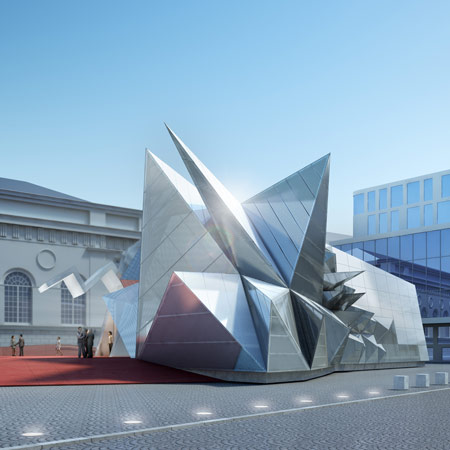Austrian architecture firm COOP HIMMELB(L)AU have unveiled their design for a temporary pavilion for the Munich Opera Festival 2010.
Called Pavilion 21 Mini Opera Space, the mobile aluminium structure will seat 300.
Made up of pyramids, the form is designed to increase its surface area and reflect external sounds.
Images are by ISOCHROM.
Here's some text from the architects:
--
COOP HIMMELB(L)AU presents design of 'Pavilion 21 MINI Opera Space' in Munich, Germany
Wolf D. Prix, Design Principal and CEO of COOP HIMMELB(L)AU presented the design for 'Pavilion 21 MINI Opera Space' for the Bavarian State Opera during a press conference in Munich in attendance of Bavarian State Minister for Sciences, Research and the Arts, Dr. Wolfgang Heubisch, Director of the Bavarian State Opera, Nikolaus Bachler as well as the Senior Vice President Brand Management of MINI, Dr. Wolfgang Armbrecht.
The task was to develop a temporary 300 seat Pavilion for the Munich Opera Festival 2010 with a multifunctional stage. Though being one of the smallest projects the Pavilion is one of the most exciting ones the design studio is working on. There is a contradiction between the requirements for mobility on the one hand and excellent acoustics on the other: mobile lightweight construction is usually not suitable for acoustic spaces which require physical mass.
As it is the case with the three opera and concert halls in China, Denmark and Spain which COOP HIMMELB(L)AU is currently planning and constructing, the acoustical properties of a space can be enhanced by tilted walls and increased surface area. Another design strategy is also to reduce the influence of external sources of sound. The Pavilion which is 21 meters long, 17 meters wide and between 6 and 8 meters high will be positioned in such a way on the Marstallplatz that it will act more as a sound reflector than as a barrier to the sound of the cars passing by.
The new digital design methods are highly appropriate to implement in a practical way the idea of surface enlargement designed as pyramid-shaped aluminum structures. Those have been generated parametrically through the overlay of sound frequencies from Jimi Hendrix’ song"…’Scuse me while I kiss the sky..." and Mozart’s opera "Don Giovanni". These shapes act either as sound reflectors or as sound reducers. The arrangement of these elements creates an iconic building consistent with COOP HIMMELB(L)AU’s principle to synergetically combine idea, form and content.

